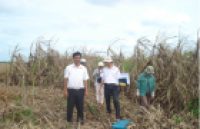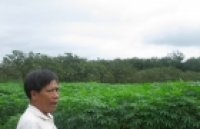| Genome-wide analysis of autophagy-associated genes in foxtail millet (Setaria italica L.) and characterization of the function of SiATG8a in conferring tolerance to nitrogen starvation in rice. |
|
Autophagy is a cellular degradation process that is highly evolutionarily-conserved in yeast, plants, and animals. In plants, autophagy plays important roles in regulating intracellular degradation and recycling of amino acids in response to nutrient starvation, senescence, and other environmental stresses. Foxtail millet (Setaria italica) has strong resistance to stresses and has been proposed as an ideal material for use in the study of the physiological mechanisms of abiotic stress tolerance in plants. |
|
Li W, Chen M, Wang E, Hu L, Hawkesford MJ, Zhong L, Chen Z5, Xu Z, Li L, Zhou Y, Guo C, Ma Y. BMC Genomics. 2016 Oct 12;17(1):797. AbstractBACKGROUND:Autophagy is a cellular degradation process that is highly evolutionarily-conserved in yeast, plants, and animals. In plants, autophagy plays important roles in regulating intracellular degradation and recycling of amino acids in response to nutrient starvation, senescence, and other environmental stresses. Foxtail millet (Setaria italica) has strong resistance to stresses and has been proposed as an ideal material for use in the study of the physiological mechanisms of abiotic stress tolerance in plants. Although the genome sequence of foxtail millet (Setaria italica) is available, the characteristics and functions of abiotic stress-related genes remain largely unknown for this species. RESULTS:A total of 37 putative ATG (autophagy-associated genes) genes in the foxtail millet genome were identified. Gene duplication analysis revealed that both segmental and tandem duplication events have played significant roles in the expansion of the ATG gene family in foxtail millet. Comparative synteny mapping between the genomes of foxtail millet and rice suggested that the ATG genes in both species have common ancestors, as their ATG genes were primarily located in similar syntenic regions. Gene expression analysis revealed the induced expression of 31 SiATG genes by one or more phytohormone treatments, 26 SiATG genes by drought, salt and cold, 24 SiATG genes by darkness and 25 SiATG genes by nitrogen starvation. Results of qRT-PCR showing that among 37 SiATG genes, the expression level of SiATG8a was the highest after nitrogen starvation treatment 24 h, suggesting its potential role in tolerance to nutrient starvation. Moreover, the heterologous expression of SiATG8a in rice improved nitrogen starvation tolerance. Compared to wild type rice, the transgenic rice performed better and had higher aboveground total nitrogen content when the plants were grown under nitrogen starvation conditions. CONCLUSIONS:Our results deepen understanding about the characteristics and functions of ATG genes in foxtail millet and also identify promising new genetic resources that should be of use in future efforts to develop varieties of foxtail millet and other crop species that have resistance to nitrogen deficiency stress.
See: https://www.ncbi.nlm.nih.gov/pubmed/27733118
Figure 1: Distribution of 37 SiATG genes onto the nine foxtail millet chromosomes. Localization of the foxtail millet ATG genes on the foxtail millet chromosomes. Tandem duplicated genes on a particular chromosome are indicated with colored boxes. Chromosomal distances are given in Mb |
|
|
|
[ Tin tức liên quan ]___________________________________________________
|


 Curently online :
Curently online :
 Total visitors :
Total visitors :
(23).png)


